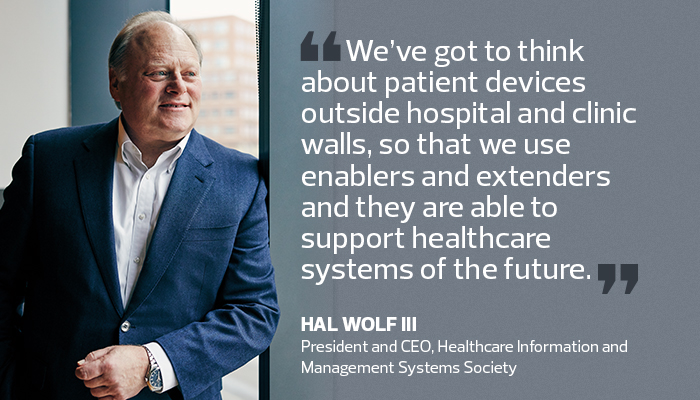Q&A: HIMSS President and CEO Hal Wolf III Looks to Prioritize Innovation in 2018 and Beyond
One of the primary goals for Harold “Hal” Wolf III, the new president and CEO of the Healthcare Information and Management Systems Society, is expanding the organization’s footprint as a global innovation organization, particularly amid challenges associated with caring for an aging population.
Wolf, who previously served in digital health leadership roles at consulting firm The Chartis Group and at Kaiser Permanente, replaced H. Stephen Lieber, who stepped down as the face of HIMSS after 17 years.
HealthTech spoke to Wolf about his vision for HIMSS moving forward, as well as what he believes provider organizations must do to balance care stability and innovation.
SIGN UP: Get more news from the HealthTech newsletter in your inbox every two weeks!
HEALTHTECH: What challenges did you face at your previous stops?
WOLF: When you go back 14 years ago to Kaiser Permanente, and you think about the healthcare landscape, we simply did not have the abundance of choices of more formulated and mature applications for analytics. We didn’t have the full depth of capabilities that many of the electronic health records have today. We had to develop and create those capabilities while the industry caught up. The biggest challenge was inventing from scratch a lot of those applications focused on population care management and care pathways.
It taught me a tremendous amount about care delivery and, in patient support, how those processes work.
HEALTHTECH: How will those experiences help you move HIMSS forward?
WOLF: It helps to better understand problems from a technologist’s point of view. Recently, we made a change to our vision statement, from “better health through IT” to “better health through information and technology.” Technology helps providers create the information that gets utilized. Use of IT was never meant to be the end of the conversation; rather, it’s the beginning.
So many of the IT leaders I’ve talked with love the subtle change because it provides recognition of what we’re accomplishing with the use of information in healthcare, and how important those underlying systems are to that dialogue. It’s definitely a reflection of my past and the conversations I’ve had with so many incredible colleagues, both on the technology side and the payer and provider sides.
HEALTHTECH: Your predecessor, Steve Lieber, served in this same role for more than 17 years and expanded the organization immensely. What are your immediate and long-term goals for HIMSS?
WOLF: The growth of HIMSS is a reflection of Steve’s leadership. In particular, HIMSS has started to grow internationally. We have a much larger footprint now, and that continues to accelerate.
Globally, the healthcare industry is trying to solve the same problems. What we are doing now is focusing on taking hold of HIMSS’ innovation segments, like Health 2.0, and expanding even more as an innovation organization.
HEALTHTECH: What do you consider to be the biggest challenge in healthcare information and technology?
WOLF: The next five to 10 years are extraordinarily important in healthcare because we face a significantly changing environment. We have this silver tsunami that’s on top of us already, with 11,000 people per day in the United States reaching 65 years of age.
As people live longer, their needs grow more expensive and chew through healthcare budgets. The bottom line is that the healthcare systems we have today are going to be underwater.

We’ve got to think more about patient health — being proactive rather than reactive. We’ve got to think about patient devices outside hospital and clinic walls, so that we use enablers and extenders and they are able to support healthcare systems of the future.
At the same time, we have to train our people about the use of data and get them to visualize how care will change. We must adjust our processes in anticipation of this and get an understanding of the flow of healthcare, how it will work as part of a community. It’s never just a patient; it’s also a patient’s family, caregiver and their peers — it’s an entire ecosystem being built.
Additionally, to support these efforts, organizations need the right data, infrastructure and technology to be able to skate to wherever that puck is going.
HEALTHTECH: Can you speak about the importance of innovation by healthcare organizations and provider-vendor relationships?
WOLF: Healthcare systems have so much on their plate. It is very hard sometimes to keep even 5 percent of time or resources available to innovate; to do something that they normally wouldn’t have time to do, but that ultimately will help better prepare them for the future.
Organizations must try to find those vendors who they know will be able to partner with them, sharing their vision to take them to the next level. Both sides, vendors and providers, have gotten better at forming partnerships that are beneficial to each other.
HEALTHTECH: You recently said that the culture of “do no harm” is contending with the culture of “innovation and failing fast” in healthcare. How can providers balance those priorities?
WOLF: There’s a natural stress point here that creates a dialogue that allows us to think through how we bring innovation in. Investment in change management and leadership are essential. The more organizations act on both, the more it will create a muscle memory that allows for faster innovation and change.








